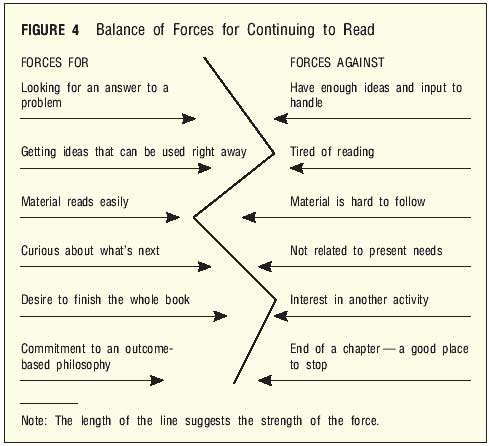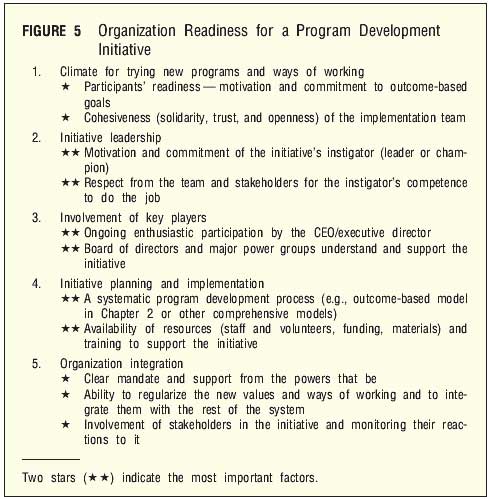8.† Change is more easily effected by reducing the
forces
against change than by strengthening the forces for it.
Situations
involving change can be analyzed by looking at the forces
for and against
change that tend to balance out and keep activity
at a given level.
Consider the university professor in a publish-or-perish
atmosphere.
Publishing more may mean a promotion, recognition,
and the
satisfaction of owning part of a book or journal.
Yet a number of
factors balance these forces, such as the solitary
nature and
loneliness of writing, the knowledge that relatively few
people ever read
professional journals, the ease with which writing
can be postponed,
and the possibility of not being published. Considering
the balance of these
factors, the professor will probably
write about one
article every year or two.
This force-field
analysis can be pictured as a giant tug-of-war,
with the supporting
forces pulling on one side and all the
restraining forces
pulling on the other. In a force field related
to my smoking
behaviour, the restraining forces easily overpower
the supporting
forces and I donít smoke, although a couple of
times sustaining
forces increased and I actually considered smoking.
One of my
associates smoked between one and two packs a day,
depending on the
balance of his forces at any moment. If tension
increased and other
smokers arrived, etc., his smoking increased; if
we were alone and
he was busy driving the car or washing dishes,
his smoking
decreased. Thus the balance is not static or routine
habit but dynamic,
changing with the balance of forces. Recently,
he had a heart
attack, and reluctantly, he quit smoking.
I have saved this
assumption about change until last because of
all the concepts
from the social sciences, I have used this one most
frequently and with
the most success. Most of my consulting work
has involved a
group doing a force-field analysis and then planning
specific strategies
to reduce the restraining factors of the proposed
change. In my early
days as a student counsellor and now in my
executive coaching,
the force field was and is used to assess the
pros and cons of
any action being considered. Exploring the
question ďWhat is
the worst thing that could happen?Ē clarifies the
fears and blockages
and frees the way to constructive planning for
managing these
problems.
Going back to the
tug-of-war analogy, increasing the supporting
forces would be
like adding more members or stronger ones to that
side of the rope.
The other team will now have to resist harder,
dig their heels in,
or lie down in their effort to hang on. However,
if one side stopped
pulling and let go of the rope, the other side
could no longer
resist ó there would be nothing to pull against.
Rather than arguing
about the pros and cons of a particular action,
the merits of both
sides are discussed and the feasibility of the proposed
action is further
tested by having both sides strategize how,
if at all, they
could reduce the restraining forces. If they are successful
in figuring out how
to remove or reduce the blockages, the
proposal will be
free to move forward.
This dynamic
suggests that in getting ready for an initiative,
the promoters will
profit from doing an analysis of the change program
using a force-field
approach and then considering ways of
reducing the factors against the change. Figure 4 depicts one possible

force-field
analysis of whether or not you will finish reading this
book. Depending on
how the forces balance for you, you will stop
reading, read a bit
more, or read a lot more. The wavy line in the
middle tries to
highlight the idea that the balance of forces may be
continually
shifting. The balance at this moment is that you will
continue reading,
but in five minutes the notion of a hot or cold
drink may get to
you and youíll stop. In a complex social system,
it is likely that
the balance of forces has set a pattern that has
become
institutionalized and will be much harder to change.
Now that we have
looked further into the process of managing
a program
development initiative and the assumptions about handling
the changes it will
trigger, letís assess your organization and
its readiness for
an initiative.
When I first began
the program development model, I had
established a
number of factors to be used to assess an organizationís
readiness (see Figure 5). Over the years these key factors of

an organizationís
readiness for a program development or organizational
improvement
initiative have been refined a bit to make up
a survey that
predicts the likely success of the initiative. While
I donít have a lot
of data from controlled studies to establish
its validity, it
does reflect my own experiences. These experiences
include eight
summers on staff in three different camps; resident
master of a
residential school for physically disabled boys; director,
Department of Group
Guidance, Montreal Childrenís Hospital;
coordinator of
staff development and training, Montreal YMCA;
teacher and leader
of adult training programs at 13 universities
in
400 nonprofit
(community-serving and government) organizations.
I report these
experiences to indicate where I am coming from
as an author and to
give some credibility to the survey shown in
Figure 6 - click here.
The above
discussion and the survey shown in Figure 6 assume
that the
outcome-based program development initiative will focus
on modifying and
changing the existing culture of the organization.
The success or
failure of the initiative will therefore depend on
whether or not the
agency adopts the new values and ways of
working of the
outcome-based model. However, there is an alternative
to trying to change
existing values and ways of working that is
well worth
describing, as it has been very successful in some of my
experiences.